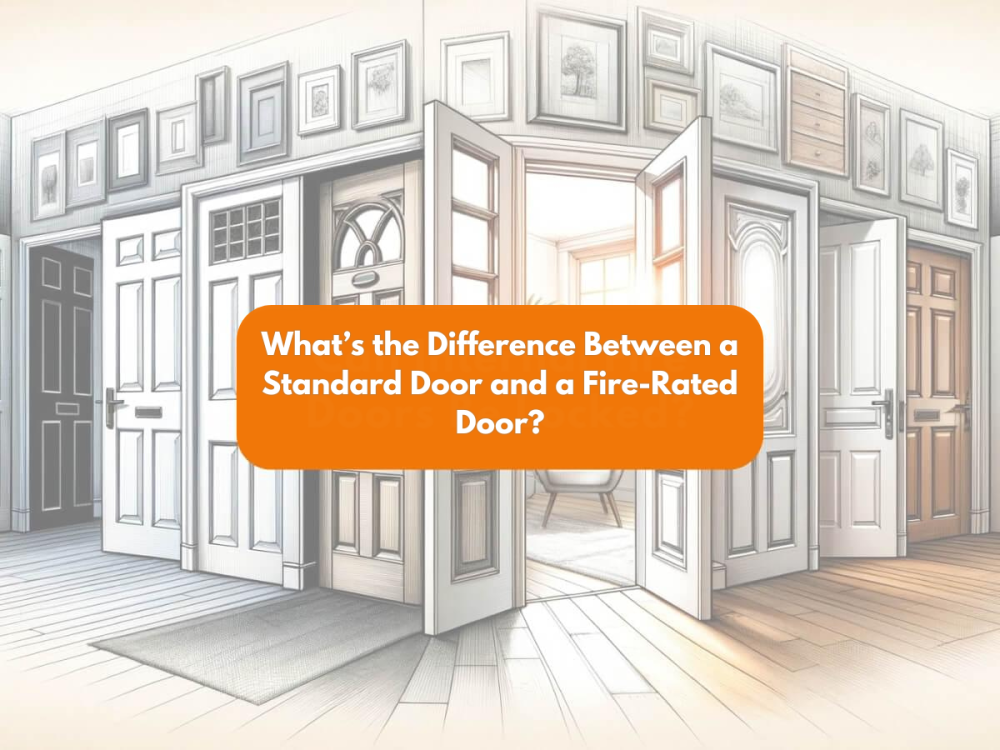Fire Door Frame: A Crucial Element for Home Safety
Key Takeaways From The Article
| Section | Key Points | Description |
| Introduction | Importance of Fire Door Frames | Highlights the crucial role of fire door frames in fire safety and door installation. |
| What is a Fire Door Frame? | Definition, Anatomy, Materials | Explains what a fire door frame is, its components, and the materials commonly used. |
| Types of Fire Door Frames | Welded, KD Drywall, KD Masonry | Describes the different types of frames and how to choose the right one based on various factors. |
| Installation Process | Steps, Tools, Common Mistakes | Outlines the installation process, tools needed, and mistakes to avoid. |
| Maintenance & Inspection | Cleaning, Damage Checks, Inspection Checklist | Discusses the importance of regular maintenance and what to look for during inspections. |
| FAQs | Special Frame, Type, Size, Inspection Frequency | Answers common questions about fire door frames, including types, sizes, and inspection frequency. |
Introduction
The Unsung Hero of Fire Safety
When it comes to fire safety, we often think of smoke alarms, fire extinguishers, and emergency escape plans. However, one crucial element that often goes unnoticed is the fire door frame. This seemingly simple component plays a pivotal role in ensuring that your fire door functions effectively, thereby safeguarding your home and loved ones.
Why Talk About Fire Door Frames?
Fire door frames are not just any frames; they are engineered to withstand high temperatures and prevent the spread of fire and smoke. They are an integral part of the fire door assembly, which includes the door leaf, frame, and hardware. Together, they create a barrier that can save lives and minimise property damage.
The Role in Fire Safety
The fire door frame works in conjunction with the fire door to seal off areas and prevent the spread of fire. It's not just about holding the door; it's about ensuring that the door fits perfectly to avoid any gaps that could let smoke or fire through.
Importance in Door Installation
This chart provides an overview of house fire statistics, emphasizing the number of injuries and how many of these fires could have been prevented with proper safety measures.
When installing a new door, especially a fire door, the frame is equally important. A poorly installed frame can compromise the effectiveness of the fire door, making it less reliable during emergencies. Therefore, it's crucial to pay attention to the frame just as much as the door itself.
A Peek into What's Coming
In this comprehensive guide, we will delve deeper into what a fire door frame is, its types, how to choose the right one, and much more. So, let's get started on this journey to make your home a safer place.
What is a Fire Door Frame?
Definition and Purpose
A fire door frame is more than just a structure that holds the door in place. It's a specially designed component that forms an essential part of a fire door assembly. The primary purpose of a fire door frame is to provide a secure and fire-resistant barrier. It works in tandem with the fire door to prevent the spread of fire and smoke between different compartments of a building.
The Anatomy of a Fire Door Frame
A typical fire door frame consists of several key elements:
- Head: The top horizontal section.
- Jambs: The side sections that run vertically.
- Sill: The bottom section (optional).
- Fire seals: Intumescent strips that expand in the event of a fire.
Materials Commonly Used
Steel Frames
Steel is the most commonly used material for fire door frames. It offers high resistance to fire and is less likely to warp or deform under extreme temperatures.
Wooden Frames
Wooden frames are generally not recommended for fire doors unless they have been specially treated to be fire-resistant. They are more aesthetically pleasing but less effective in a fire.
Metal Frames
Apart from steel, other metals like aluminum and iron are also used. However, they are generally not as effective as steel.
| Material | Fire Resistance | Aesthetic Appeal | Cost |
| Steel | High | Low | High |
| Wood | Low | High | Low |
| Metal | Medium | Medium | Medium |
Why is the Frame Material Important?
The chart illustrates the significance of fire door frames in slowing down the spread of fire, highlighting their importance in home safety
Choosing the right material for your fire door frame is not just a matter of aesthetics; it's a matter of safety. The material determines how well the frame will resist fire and contribute to the overall effectiveness of your fire door system.
Types of Fire Door Frames
An Array of Choices
When it comes to fire door frames, one size doesn't fit all. There are various types designed to meet different needs and specifications. Understanding these types is crucial for making an informed decision.
Welded Metal Frame
Welded metal frames are one-piece frames that are welded together to form a sturdy structure. These are most commonly used in commercial settings but can also be effective in residential buildings. They offer high fire resistance and are generally made of steel.
KD Drywall Frame
KD (Knock-Down) Drywall Frames are designed for easy installation in drywall constructions. These frames come in multiple pieces and are assembled on-site, making them a convenient choice for renovations or new constructions.
KD Masonry Frame
Similar to KD Drywall Frames, KD Masonry Frames are designed for masonry walls. They are also assembled on-site and offer a good level of fire resistance.
| Type of Frame | Ease of Installation | Fire Resistance | Best Suited For |
| Welded Metal | Low | High | Commercial Buildings |
| KD Drywall | High | Medium | Renovations, New Constructions |
| KD Masonry | Medium | High | Masonry Walls |
How to Choose the Right Type of Frame
Consider the Wall Type
The type of wall where the frame will be installed plays a significant role in your choice. For drywall, KD Drywall Frames are ideal, while masonry walls are best suited for KD Masonry Frames.
Consider the Door Type
The type of fire door you choose will also influence the frame you need. For example, a heavy-duty steel door will require a robust frame like a welded metal frame.
Consider the Fire Rating
Different frames come with different fire ratings, usually ranging from 30 minutes to 3 hours. Make sure the frame you choose has a fire rating that matches or exceeds that of your fire door.
Installation Process
The Importance of Proper Installation
Installing a fire door frame is not a DIY project; it requires precision and expertise. A poorly installed frame can compromise the effectiveness of your fire door, putting your property and lives at risk. Therefore, it's crucial to either be well-versed in the installation process or hire professionals.
Steps for Installing a Fire Door Frame
- Measure the Opening: Accurate measurements are crucial for a snug fit.
- Prepare the Wall: Ensure the wall where the frame will be installed is clean and level.
- Assemble the Frame: If you're using a KD frame, assemble it according to the manufacturer's instructions.
- Install the Frame: Secure the frame into the wall opening using appropriate fasteners.
- Check for Gaps: Ensure there are no gaps between the frame and the wall.
- Install Fire Seals: Intumescent strips should be installed in the grooves of the frame.
- Attach the Door: Finally, install the fire door into the frame.
Tools Needed for Installation
- Tape Measure
- Level
- Screwdriver
- Hammer
- Drill
Common Installation Mistakes to Avoid
Incorrect Measurements
One of the most common mistakes is taking incorrect measurements, which can result in a poor fit and compromise the fire safety of the door.
Inadequate Fire Seals
Failing to install fire seals or using inferior-quality seals can severely affect the fire resistance of the door frame.
Using Wrong Fasteners
Using the wrong type or size of fasteners can weaken the frame's hold, making it less effective during a fire.
| Common Mistakes | Consequences | How to Avoid |
| Incorrect Measurements | Poor fit, compromised safety | Double-check measurements |
| Inadequate Fire Seals | Reduced fire resistance | Use high-quality seals |
| Wrong Fasteners | Weakened frame | Follow manufacturer guidelines |
Maintenance and Inspection
The chart provides a recommended maintenance schedule for fire door frames, ensuring they remain effective and safe over tim
The Lifeline of a Fire Door Frame
A fire door frame isn't a set-it-and-forget-it component. Regular maintenance and inspection are crucial for its longevity and effectiveness. Neglecting this can lead to a compromised fire door system, putting your safety at risk.
How to Maintain a Fire Door Frame
Cleaning
Regular cleaning is essential to remove any dust or debris that might affect the frame's integrity. Use a mild detergent and a soft cloth for this purpose.
Check for Damages
Inspect the frame for any signs of wear and tear, such as cracks or deformities. If you find any, it's time for a replacement.
Reapply Fire Seals
The intumescent strips in the frame may wear out over time. Make sure to replace them as needed.
Importance of Regular Inspections
Routine inspections are not just a good practice but often a legal requirement. These inspections ensure that the frame, along with the fire door, is in optimal condition to provide maximum protection.
Inspection Checklist
- Frame Integrity: Check for any signs of damage or wear.
- Fire Seals: Ensure the intumescent strips are in good condition.
- Fasteners: Make sure all screws and other fasteners are tightly secured.
- Alignment: The frame should be perfectly aligned with the door.
- Gaps: There should be no gaps between the frame and the wall or the door.
| Inspection Item | What to Look For | Action if Compromised |
| Frame Integrity | Cracks, deformities | Replace the frame |
| Fire Seals | Worn-out strips | Replace the seals |
| Fasteners | Loose screws | Tighten or replace |
FAQs
Your Burning Questions Answered
Fire door frames are a complex subject, and it's natural to have questions. In this section, we'll tackle some of the most frequently asked questions to help you gain a better understanding of this crucial component in your fire door system.
Does a Fire Door Need a Special Frame?
Yes, a fire door does require a special frame that is designed to withstand high temperatures and prevent the spread of fire and smoke. A standard door frame won't provide the same level of protection.
What Kind of Frame Do You Need for a Fire Door?
The type of frame you need depends on various factors such as the type of wall, the fire rating required, and the material of the door. Steel frames are generally the most fire-resistant, but KD frames can also be suitable depending on the application.
What Size is a Fire Door Frame?
The size of a fire door frame is determined by the size of the fire door it will hold. It's crucial to take accurate measurements to ensure a snug fit, as any gaps can compromise the effectiveness of the fire door.
How Often Should a Fire Door Frame Be Inspected?
It's recommended to inspect your fire door frame at least once a year. However, in commercial settings or high-risk areas, more frequent inspections may be necessary.
| FAQ | Answer Summary |
| Special Frame Needed | Yes, for fire resistance |
| Type of Frame | Depends on wall type, fire rating, and door |
| Frame Size | Determined by door size |
| Inspection Frequency | At least annually, more often in high-risk areas |














